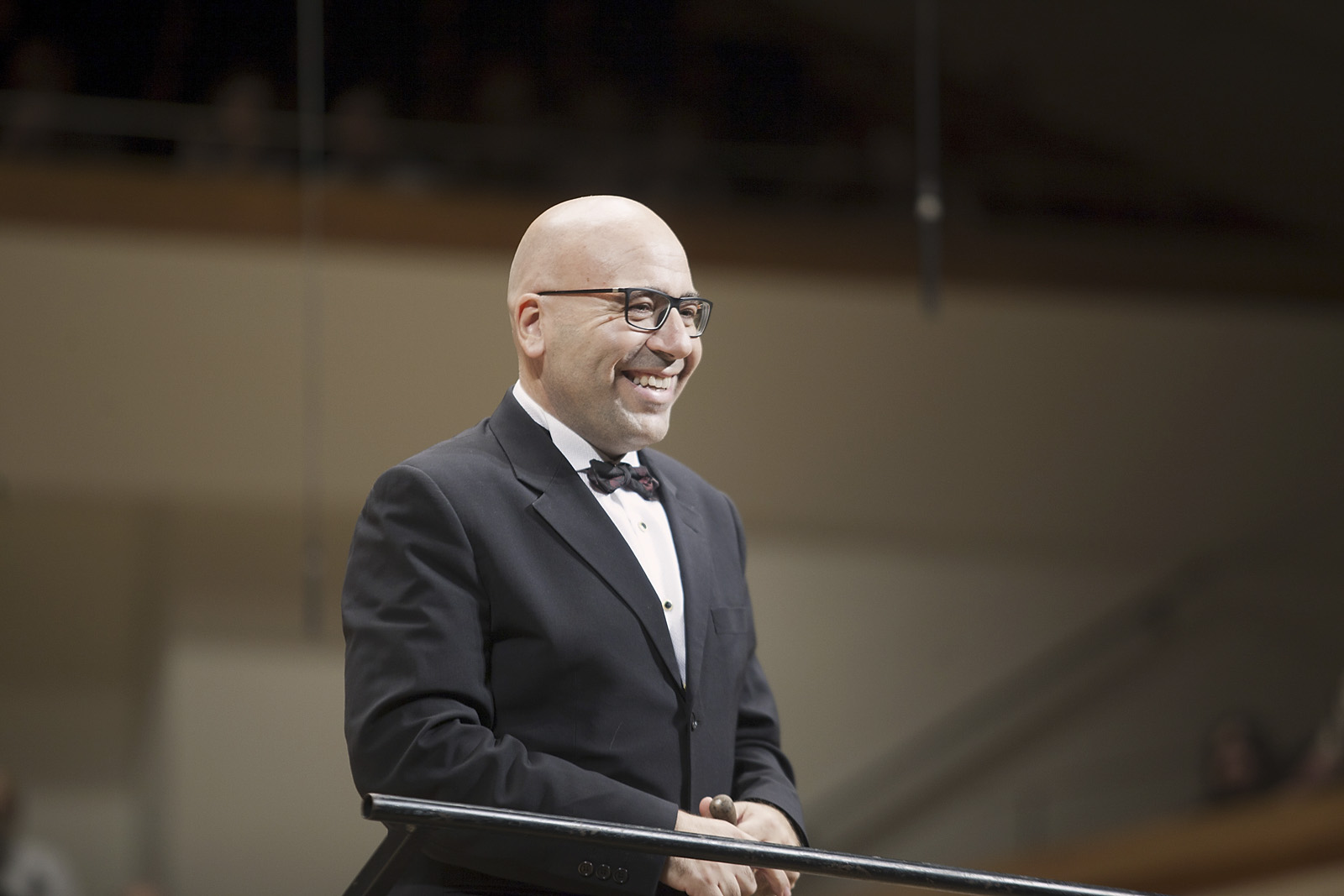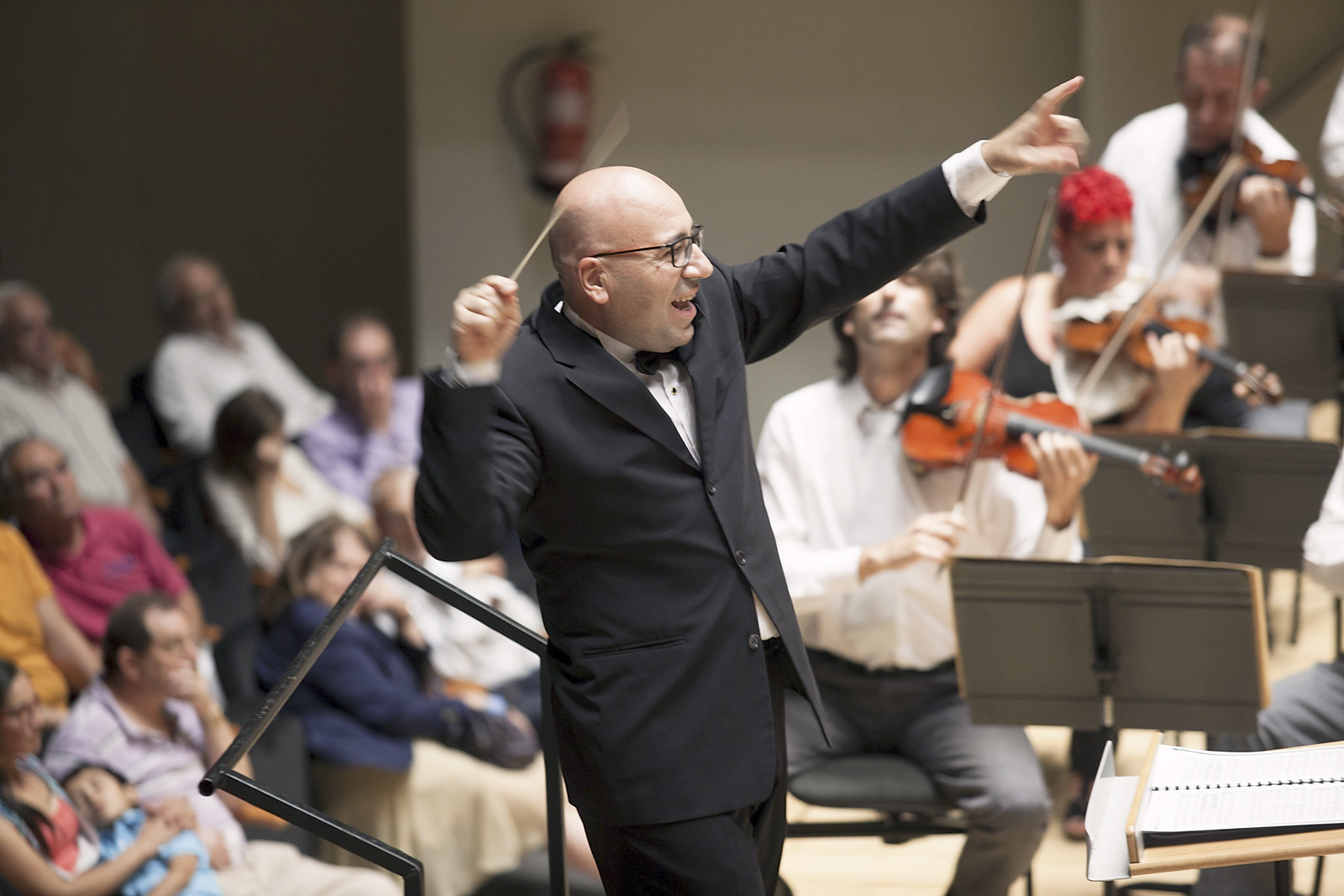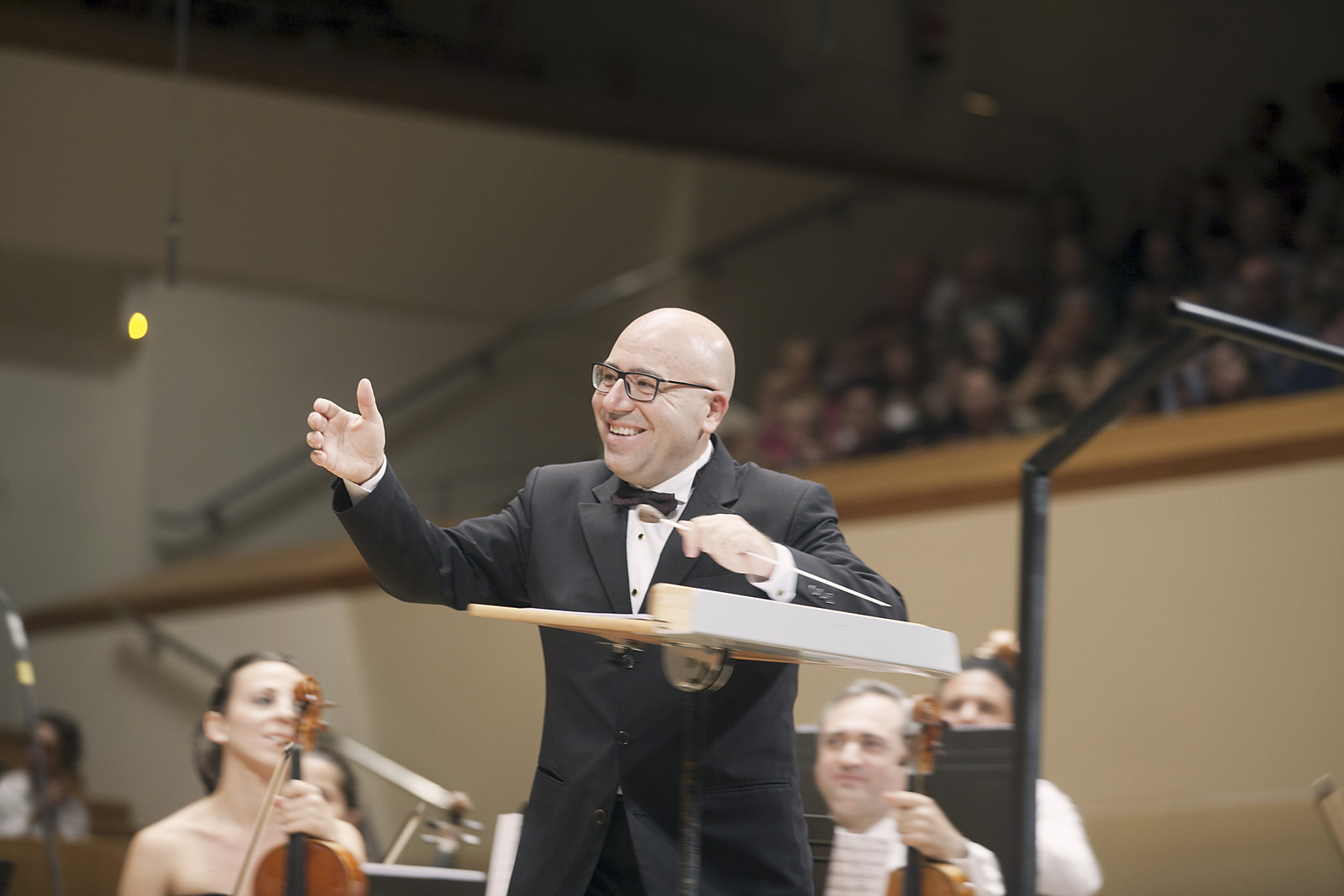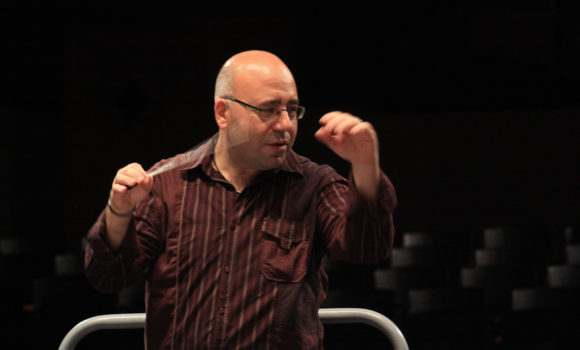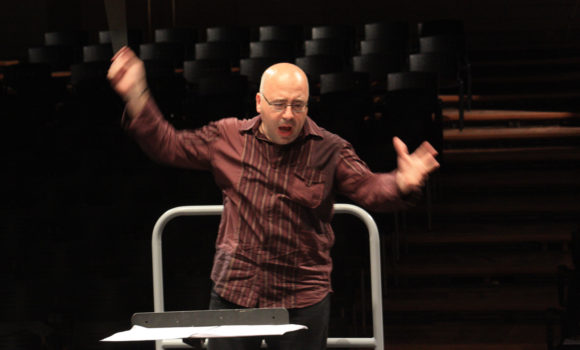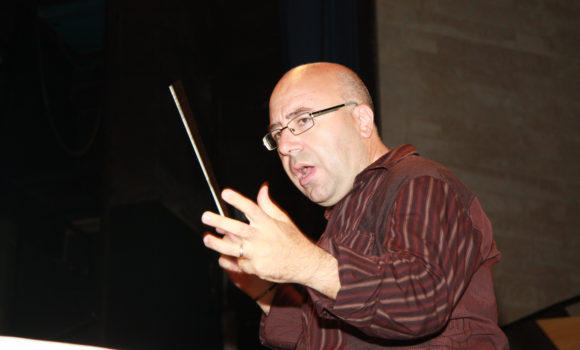Ferrer Ferran, el sueño del compositor
… Cual es el pensamiento de un creador?… será pura técnica…, simplemente una inspiración…, o el conjunto de ambas dos?…, quizá motivación…, o la necesidad de extraer el interior de un conjunto de sentimientos que florecen de un corazón?…
Ferrer Ferran predica felicidad al escuchar música, hacer feliz interpretando aquellos sonidos que salen del corazón, nos habla de “magia”, y nos dice que debemos soñar y elevarnos, menciona que la música es tan maravillosa que no existe descripción alguna para definirla, habla de sensaciones…, mejor…, de buenas sensaciones…
Él nos invita a “soñar” con su música, nos hace cerrar los ojos para adentrarnos en un viaje de emociones maravillosas…, subamos a este sueño y dejémonos llevar…..
Ferrer Ferran es capaz de seducirnos con un precioso amanecer, el alba reflejado en los parajes recorridos en tierras manchegas (En un Lugar de La Mancha, 2003), (Alba Overture, 2012)por Alonso Quijano, Don Quijote de La Mancha; el caballero de la triste figura, (El Quijote, 2004), (El Ingenioso Hidalgo, 2005), recorrer la región de Calabria para ubicarnos en la provincia de Cosenza,describiendo su enclave monumental (Amantea, 2016), o visitar los viñedos de la Costa Dorada francesa (Côte D´Or, 1998), y al mismo tiempo sorprendernos con un espectáculo pirotécnico (Fuegos del Alma, 2014) que nos lleve a celebrar un nuevo año (Chanson du Nouvel An, 2014).
Evocaremos episodios históricos, desde los vestigios romanos de Vilela en Portugal con su posterior legado musulmán (Vilela, 2010), pasando por las incursiones de Napoleón en el italiano Valle de Aosta (L´Insurrection, 2014) y en la pequeña localidad de Quart de Poblet (Miliarium, 2016 ), la ciudad portuaria del siglo XVII destruida bajo el agua en Port Royal, Jamaica (The Submerged City, 1997), las alusiones al mismo Bonaparte realizadas por Goya y fielmente reflejadas por Ferrer en su cuarta sinfonía ( El Coloso, Sinfonía n. 4, 2011), así como la partida de ajedrez entre dos grandes maestros, Andersseny Kiesevitzki, considerada una de las más bellas que se han jugado a lo largo de la historia (La Inmortal, 1998). Nos trasladaremos también al enfrentamiento entre las tropas anglo-españolas contra las francesas (La Batalla de Chiclana, 2010), nos conmoveremos con las danzas del “Conqueridor”,Jaume I, fiel reflejo de la batalla de Sucro en la más cercana localidad de Algemesí (Aljama, 1999), (Algemiz, 1999), y más recientemente la guerra del Golfo Pérsico que empezó con la invasión y anexión de Kuwait por las tropas Iraquíes (Tormenta del Desierto, Sinfonía n. 1, 2000).
La creatividad de Ferrer Ferran la podremos escuchar a través de protagonistas de cuentos como Asterix y Obelix, (Bandsterix & Euphonix, 2010) y (Bandsterix & Tubelix,2011), y los inolvidables clásicos de Disney (Pepito Grillo, 2009), (Baghira, 2000) y (Saxiland, 2000), o de los dibujos animados que nos han acompañado toda nuestra vida (Tbon and Jacques, 2016), (El Gato con Botas, 2016)empleando un lenguaje divertido y atrayente en el que no faltan toques cómicos ni la sensibilidad necesaria para emocionarnos con la metáfora esencial de “El Principito” (Las Aventuras del Principito, 2012), o de aquel niño de madera que cobra vida mientras está siendo tallado por su carpintero Gepetto (Pinocchio, 2007).
Ferrer Ferran, nos hace regresar al país de Nunca Jamás de la mano de Peter Pan y el hada Campanilla dejándonos llevar por un bonito sueño, el del niño que nunca quiso crecer (Peter Pan, 2016), para comenzar una nueva aventura hacia una historia interminable (El Sueño sin Fin, The Neverending Dream, 2017), imaginándonos junto a los pequeños seres que aparecen en los bosques profundos (A Fairy Tale, 2009), y volando hacia un universo repleto de juguetes,ilusión y ensueño (Toyland Suite, 2004).
También es capaz de recrearnos en los clásicos de la literatura de aventuras y musicalizar la legendaria obra de Alejandro Dumas, y de la mano de D’Artagnan salvaguardar el honor de la reina de Austria junto a sus infatigables mosqueteros (Los Cuatro Mosqueteros, 2016).
Observaremos la versatilidad de sus composiciones y podremos comprobar la fuerza de su música, escucharemos gritos y rugidos en la portuguesa población de Paredes bajando a la “Boca do Inferno” (Castelo do Inferno, 2004), sentiremos el trastorno psiquiátrico del extraño caso del Dr. Jeckyll y el señor Hyde (The Castle of Dr.Bassclar,2013) y podremos sentir el tormento y el terror del mundo de los muertos y sus almas errantes (O Camiño das Animas en Pena, 2010) , todo ello desde lenguajes apropiados capaces de ser empleados con precisión y fuerza para hacernos percibir las más diversas emociones, bien a través de una escritura misteriosa de gran envergadura (Concert n.3, 2013), de la música pura buscando el protagonismo de todos los instrumentos de la Orquesta (Concert per a Orquestra de Vents y Percussió, Concert n. 1, 2008), (Alba Sapientia, Concert n. 2, 2008), o de la finura melódicadel Himno a la festividad de los músicos, Sta. Cecilia (Auditorio Florida, 2006).
El empleo de la forma musical adecuada nos desvela el amplio abanico de opciones que el autor pone a nuestra disposición en su amplio repertorio, mostrándonos de lo que es capaz al escoger la forma apropiada para cada pieza; así podremos deleitarnos con un elegante Bolero (El Bolero de Carmelo, 2009), la garra del cante (Mont Serrat, 2008) y elFandango, (Cabeza Compostizo, 2012) en una fantasía española desbordante (Mar i Bel, 1999). Nos trasladaremos a los años 60 al ritmo de preciosas baladas (La Veu de la Trompeta, 2009), (La Veu de la Tuba, 2009), (Raffaello, 2012) y nos adentraremos en el mundo del Jazz a través de la mano de Charlie Parker y su saxofón (Spanish Parker, 2015).
Viajar, descubrir, acercarnos a las costumbres populares de la gente y trasladarlas con la mayor fidelidad es un talento innato del compositor, de esta manera conoceremos las costumbres de Pasto en Colombia (Ciudad Sorpresa, 2013), de los Guanches (Taoro, 2015), del origen de la Isla de Tenerife (Nivaria, 2015), las costumbres populares españolas (Don Pajarita, 2006) , y como no, de la propia tierra del compositor bien a ritmo de pasodoble (Música i Poble, 2000), composiciones para ser ejecutadas por los mejores solistas internacionales (Te Bon e Paiporta, 2008),o humanizar la propia naturaleza en forma degigante, el contrabajo (El Gegant de Fusta, 2017), o la Tuba (El Gigante de Hierro, 2017) y todo ello sin olvidarnos de pasear por el Tirol austríaco del siglo XII a ritmo de Vals (Destellos del Alba, 2014).
Pero la obra de Ferrer Ferran va más allá… hemos explorado la magia de protagonistas de cuentos, la expresividad en el relato de episodios históricos, la fuerza del terror y su dominio de cualquier forma musical, peroFerran es capaz de llevarnos a mundos más complejos, desde crear narraciones de origen sagrado hasta una serie de creencias de carácter imaginario, y componer relatos basados en la tradición y la leyenda.
La mitología romana nos llevará hacia esos fenómenos que no tienen una explicación simple, con una hermosa melodía de flauta al misterio de los faunos (Tumnus, 2006), de la mitología griega con la diosa de la música (Euterpe, 2003), portaremos el cuerno con el guardian de los dioses de la mitología escandinava (Gjallarhorn, 2004), y con el gran temido monstruo acuático de múltiples cabezas serpentinas (Hydra Concerto, 2001). Nos sentiremos agasajados en palacios de grandes murallas por el Guardian de los Vientos (Eolo, el Rey, 1999) y un paseo por el Egipto más remoto de la mano del Dios Sanador de la Mitología Egipcia (Horus, 2002), o todavía, podemos viajar a un pasado mucho más remoto, Ferrer nos conduce 65 millones de años atrás a sentirnos al lado de uno de los más carismáticos dinosaurios (Tyrannosaurus Rex, 2012), o de los temidos dragones (Red Dragon, 2008).
Batallas, magia, viajes, mitología yhechos bíblicos. En la obra sinfónica del Maestro no podían faltar alegorías a ritos religiosos y por supuesto escritos de manera atrayente (Misa Sinfónica, 2010), alusiones a personajes bíblicos (Abraham, 2009) o el Angel expulsado del cielo (Sonata del Angel Caído, 2003),del Antiguo y Nuevo Testamento (La Passió de Crist, 2001), (Els Pecats Capitals, 2004), (Salomón, 2006), y asistiremos a la victoria del desvalidofrenteal poderoso en esa conocida metáfora de David y Goliat (Davide e Golia, 2015), sin olvidarnos de la melodía simple, pulcra y atrayente que nos hará viajar a Los Realejos en Santa Cruz de Tenerife (El Siervo de Yahvé, 2010).La antigüedad también queda reflejada en la obra de Ferrer Ferran, culturas antiguas ambientadas en el Egipto de hace 3000 años, (Abu Simbel, 2009).
Su bondad y generosidad le llevan a homenajear a grandes personastitulando música para inmortalizarlas en el tiempo (Maestro Lino, 2006), (Consuelo Císcar, 2002), (Maestro Ravetto, 2016), (Luis “El Huiso”, 2010), (Nelo el Sorli, 2014), (Olé Toronto, 1995), (Miguel Carlos Gómez Perona, 2011), (Antonio Estevan López, 2011), (Tío Alberola, 2005), Asociaciones Culturales (Amunt Pirris, 2016), (Al Centenario, 1997), (Consolat De Mar, 2006), (Federband, 2006),o esa banda diferente existente en Bussoleno, Italia (La Mía Banda é Differente, 2014). Personajes que dieron la vuelta al mundo por primera vez (Magallanes, 2002), la heroica y Santa francesa (Juana de Arco, 2005),sin olvidar los majestuosos monumentos (IVAM, 2007), (Porta del Serrans, 2013), (Ceremonial, 2001), (La Torre de Hercules, 2007), (The Great Spirit, Sinfonia n. 3, 2005), las antiguas murallas del Castillo de Almansa (Al-Manzah, 2008)resaltando enclaves naturales (Êcho de la Montagne, 2003), (Acqua Alpina, 2010), (El Bosque Mágico, 2001)que se han convertido en lugares emblemáticos y seductores con culturas ancestrales de Africa (Jungla, 2006), (El Rugir del Kimbo, 2004).
Ferrer Ferran además de dedicarse a la composición mantiene una intensa actividad pedagógica como docente y como ponente en multitud de conferencias y clases magistrales. La pasión por la enseñanza también le ha llevado a la composición de obras sencillas de carácter pedagógico (El Sol Redó, 2012), (La Escala Sidó, 2006), (El Caracol Mifasol, 2005), (Sonatur, 2016), sin olvidar aquel primer instrumento con el que todos los niños comienzan en este bonito mundo de la música, la flauta dulce, (Piccole Note, 2016).
Las obras de carácter solidario también forman parte de su catálogo, como la implicación con el autismo (Burbujas del Sentido, 2015), (Canto a UNICEF, 1996), (Il Suono del Corno , 2008), o (Músicos sin Fronteras, 2012), ONG del mismo nombre de la pieza, volcada en crear un compromiso solidarioentre la música y la infancia más desfavorecida.
En el interior de estas letras se puede descubrir la fuerza de su música, la variedad de estilos y la calidad de su obra. Por esta razón nosotros estamos aquí con las principales virtudes del compositor, su jovialidad y pasión por la música, creando notas de humor (Comic Overture, 2000), su alegría con una fantasía para saxofón (Jovintud, 2005), pero sobre todo, su capacidad de amar y transmitir, por ello, te invitamos a soñar en la Maggiorana, escuela de cocina en Rivoli, Italia (La Maggiorana, 2016), a sentir con la melodía para trompeta (Tu Sueño, 2007), a degustar una buena gastronomía (Los Barbas, 2012), a subir en un tiovivo (Carrousel, 2013), y a disfrutar de la música bailando al son de las marionetas y los titiriteros, (Bassi La Marioneta, 1999).
En esta web llena de magia aparece su maravillosa obra, por si durante este viaje quieres descubrirla con ánimo y minuciosidad.Recuerda que Ferrer Ferran vive en una ciudad cuyas fiestas principalesson “Las Fallas” donde la música, la pólvora y el arte fallero nunca faltan, y como no podía ser menos lo refleja fielmente con su música (Actualidad Fallera, 2016), (Marta Alandete, 2016), (Lorena Tomás, 2016), (Raquel Alario, 2017).
… Y con todo esto, Ferrer Ferran siempre recuerda las palabras de su admirado Maestro, Jef Penders (Bravo Mestre, 1997). El que le enseñó a amar y respetar la música para componer con el corazón …
… Ferran es fiel a este pensamiento porque “felizmente ordena esas notas dejadas caer en un papel pautado”, siendo su mayor interés “soñar y hacer feliz al mundo con su música” …
Ferrer Ferran, the dream of the composer
…Which is the thought process of a creator?…will it be pure technique…, a simply inspiration…, or a set of both?…, perhaps motivation…, or the need of extracting the inside of a whole host of feelings that bloom from a heart?…
Ferrer Ferran preaches happiness by listening to music, making happy interpreting those sounds from the heart, he also tells us about “magic”, and says we need to dream and rise, he mentions that music is so marvelous that there is no description to define it, he speaks about sensations…, better…, about good feelings…
He invites us to “dream” with his music, making us close the eyes to immerse in a journey of wonderful sensations…, let us join the dream and allow ourselves go…
Ferrer Ferran is able to seduce us by a wonderful sunrise, the dawn is reflected on the areas covered through Manchego lands (En un Lugar de La Mancha / “ In a Town in La Mancha”, 2003), (Alba Overture, 2012) by Alonso Quijano, Don Quixote of La Mancha; the knight of the sad figure (El Quijote / “The Quixote”, 2004), (El Ingenioso Hidalgo / “The Ingenious Hidalgo”, 2005), around Calabria region for locating us in the province of Cosenza, describing its monumental enclave (Amantea, 2016), or visiting the vineyards from the French Gold Coast (Côte D´Or, 1998) and at the same time being surprised with a firework display (Fuegos del Alma / “Fires from the Soul”, 2014) which takes us to celebrate a new year (Chanson du Nouvel An, 2014).
Historical episodes will be recalled, from the Vilela Roman remains in Portugal with its later muslim legacy (Vilela, 2010), going through the incursions of Napoleon in the Italian Aosta Valley, (L´Insurrection, 2014) and in the small town of Quart de Poblet (Miliarium, 2016), a port city in the XVII century in Port Royal (Jamaica) destroyed underwater (The Submerged City, 1997), the allusions to Bonaparte did by Goya and faithfully reflected by Ferrer in his 4th Symphony (El Coloso, Sinfonía n. 4 / “The Colossus, Symphony n.4”, 2011), as well as the most famous chess match between two great masters, Anderssen and Kiesevitzki, historically considered one of the most finest ever played (La Inmortal / “The Inmortal”, 1998). We will also takeplace to the confrontation between the anglo-spanish troops against the french (La Batalla de Chiclana / “The Battle of Chiclana”, 2010), we will be moved by the dance of the “Conqueror”James I as a devoted reflection of the Sucro Battle in the nearest town of Algemesí (Aljama, 1999), (Algemiz, 1999), and more recently the Persian Gulf War that began with the invasion and occupation of Kuwait by Iraqi forces (Tormenta del Desierto, Sinfonía n. 1 / “Desert Storm, Symphony n. 1″, 2000).
We could listen the creativity of Ferrer Ferran through the tales main characters such as Asterix and Obelix, (Bandsterix & Euphonix, 2010) and (Bandsterix & Tubelix, 2011), as well as the unforgettable Walt Disney classics (Pepito Grillo / “Jiminy Cricket”, 2009), (Baghira, 2000), and (Saxiland, 2000) or the cartoons that have been with us throughout our life (Tbon and Jacques, 2016), (Il Gatto con gli Stivali / “Puss in Boots“, 2016) using an amusing and appealing language which is plenty of comic touches and the essential sensitivity to thrill us with the metaphor from “The Little Prince”(Las Aventuras del Principito / “The Adventures of the Little Prince”, 2012) or the wooden child that comes to life while is being carved by his carpenter Gepetto (Pinocchio, 2007).
Ferrer Ferran brings us back to Neverland accompanied by Peter Pan and Tinkerbell letting ourselves go among a pleasing dream, the child who never wanted to grow up (Peter Pan, 2016), to begin a new adventure towards a never-ending story (The Neverending Dream, 2017), imagining ourselves next to the little beings who appear in the deep forest (A Fairy Tale, 2009), and flying toward a universe full of toys, illusion, and enchantment (Toyland Suite, 2004).
He is also able to recreate us into the classics of the adventure literature, setting the legendary work by Alejandro Dumas into music hand in hand with D´Artagnan to safeguard the honor of the queen of Austria with her tireless musketeers (Los Cuatro Mosqueteros / “The Fourth Musketeers”, 2016).
We will observe the versatility of his compositions and will verify the power in his music, listening cries and roarings in the Portuguese municipality of Paredes, going down to the “Boca do Inferno”(Castelo do Inferno / “The Castle of the Inferno”, 2004), feeling the psychiatric condition of the strange case of Dr.Jekyll and Mr. Hyde (The Castle of Dr. Bassclar, 2013) and we also shall feel the torment and the terror from the world of the dead and the wandering souls (O Camiño das Animas en Pena / “The Path of the Dark Souls”, 2010), all this from the most appropriate languages able tobe precisely and vigorously employed to let us perceive many different emotions, either from a mysterious with large-scale composition (Concert n. 3, 2013), from the pure music pursuing the leading role of all the instruments from the Orchestra (Concert per a Orquestra de Vents i Percussió, Concert n. 1, 2008), (Alba Sapientia, Concert n. 2, 2008) or from the melodic finesse in the Anthem to the festivity of Saint Cecilia (Auditorio Florida, 2006).
The proper use of the musical form reveals us the wide range of options the author place at our disposal in his extensive repertoire, showing us what is capable of choosing in an appropriate way for each composition; and thus shall delight with an elegant Bolero (Spanish dance characterized by sharps turns, stamping on the feet, and sudden pauses in a position with one arm arched over the head) (El Bolero de Carmelo, 2009 / “The Bolero of Carmelo“) the strength of the vocals (Mont Serrat, 2008) and the Fandango (Spanish dance by a man and a woman to the accompaniment of guitar and castanets) (Cabeza Compostizo, 2012) in an overflowing Spanish fantasy (Mar i Bel, 1999). We shall move to the nineteen-sixties at the rhythm of wonderful waltzes (La Veu de la Trompeta / “The Voice of the Trumpet”, 2009), (La Veu de la Tuba / “The Voice of the Bass Tuba”, 2009), (Rafaello, 2012 / “Raphael“) and we shall delve into the world of Jazz hand in hand with Charlie Parker and his saxophone (Spanish Parker, 2015).
Traveling, discovering,approaching to the people´s popular traditions and transfer them as faithfully as possible is a natural born talent from the composer, in this way we will come to know the habits from Pasto in Colombia (Ciudad Sorpresa / “Surprise City”, 2013), from the Guanches (primitive habitants from Tenerife, Canary Islands, Spain) (Taoro, 2015), from the origin of the Isle of Tenerife (Nivaria, 2015), the Spanish traditional costumes (Don Pajarita / “Mr. Bow Tie”, 2006), and as could not be otherwise, from the own land of the composer to the rhythm of pasodoble (Música i Poble, 2000), compositions to be interpreted by the finest international soloists (Te Bon e Paiporta, 2008), or humanize the very nature in giant form, the Double Bass (El Gegant de Fusta / “The Giant of Wood”, 2017), or the Tuba (El Gigante de Hierro / “The Giant of Iron“, 2017), and all of which without forgetting to take a walk through the XII century Austrian Tyrol to the rhythm of Waltz (Destellos del Alba / “Flashes of the Dawn”, 2014).
However, the creation by Ferrer Ferran goes beyond…we have explored the magic of the story tales main characters, the expressiveness in the narrative of the historical episodes, the terror force and his command of any musical composition, however Ferrer Ferran is capable of leading us towards more complex worlds, is able to create from narratives of sacred origin, to beliefs with imaginary character, andcompose stories based on tradition and legend.
Roman mythology will lead us towards those events with no simple explanation from them, with a charming flute melody to the fauns mystery (Tumnus, 2006), from Greek mythology with the Goddesses of music (Euterpe, 2003), we will carry the horn with the Gods world in Scandinavian mythology (Gjallarhorn, 2004), with the great feared water-snake-like monster (Hydra Concierto, 2001). We will be greeted in palaces with extensive walls by the Keeper of the Wind (Eolo, el Rey / “Eolo, the King”, 1999) and also a stroll through the most remote Egypt hand in hand with the God the Healer from Egyptian mythology (Horus, 2002), or we can go back even more to a remote past,Ferrer Ferran leads us 65 million years ago next to the most charismatic dinosaurs (Tyrannosaurus Rex, 2012), or to the feared dragons (Red Dragon, 2008).
Battles, magic, tours, mythology and biblical events. In the Symphonic creation by the Master could not be left out allegories of religious rites and certainly writings in an engaging way (Misa Sinfónica / “Symphonic Mass”, 2010), allusions to biblical characters (Abraham, 2009) or the Angel expelled from heaven (Sonata del Angel Caído / “Angel´s Fallen Sonata”, 2003), from the Old and New Testaments (La Passió de Crist / “The Passion of Christ”, 2001), (Els Pecats Capitals/ “The Capital Sins”,2004), (Salomón, 2006), and we will attend the victory from the helpless against the potentin the well-known metaphor from David and Goliath (Davide e Golia, 2015), without forgetting the simple, immaculate and appealing melody that will enable us to travel to “Los Realejos”(a municipality the northern part of Tenerife Island, which forms part of the Canary Islands) (El Siervo de Yahvé / “Yahve’s Servant”, 2010). The antiquity is also reflected in the work by Ferrer Ferran, ancient cultures set in Egypt 3000 years ago (Abu Simbel, 2009).
His goodness and generosity lead him to pay tribute to great figures entitling music to immortalize them in time (Maestro Lino, 2006), (Consuelo Císcar, 2002), (Maestro Ravetto, 2016), (Luis “El Huiso”, 2010), (Nelo el Sorli, 2014), (Olé Toronto, 1995), (Miguel Carlos Gómez Perona, 2011), (Antonio Estevan Lopez, 2011), (Tío Alberola, 2005), Asociaciones Culturales (Amunt Pirris, 2016), (Al Centenario, 1997), (Consolat De Mar, 2006), (Federband, 2006), or that different band existing in Bussoleno, Italy (La Mía Banda é Differente, 2014). Figures who went on a round-the-worl-tour for the first time (Magallanes, 2002), the heroic and french saint (Juana de Arco / “Joan of Arc”, 2005), without forgetting the majestic monuments (IVAM, 2007), (Porta del Serrans, 2013), (Ceremonial, 2001), (La Torre de Hércules/ “The Tower of Hercules”, 2007), (The Great Spirit (Sinfonia n. 3), 2005), the old walls of the Almansa Castle (Al-Manzah, 2008), highlighting natural enclaves (Êcho de la Montagne, 2003), (Acqua Alpina, 2010), (El Bosque Mágico / “The Magic Forest”, 2001), that have become in emblematic and appealing places with ancestral cultures from Africa (Jungla, 2006), (El Rugir del Kimbo, 2004 / “The Roar of Kimbo“).
In addition to devote to composition, Ferrer Ferran maintains an intensive pedagogical activity as a teacher and as a speaker at conferences and master classes. The passion for teaching has also led him to compose uncomplicated pedagogical pieces (El Sol Redó, 2012), (La escala Sidó, 2006), (El Caracol Mifasol, 2005), (Sonatur, 2016), as well as that first instrument which all the children begin playing in this wonderfulworld of music, the recorder (Piccole Note, 2016).
The compositions with a solidarity character are also shown in his catalogue as his involvement in the autism (Burbujas del Sentido / “Bubbles of Sense”, 2015), (Canto a UNICEF / “A Chant to UNICEF, 1996), (Il Suono del Corno, 2008) or (Músicos sin fronteras / “Musicians without Borders”, 2012) NGO whose name is the same as the composition thrown on creating a supportive commitment between the music and the disadvantaged childhood.
Within these pages is able to discover the strength of his music, the variety of different styles and the quality of his work. For this reason we are here with themain strengths of the composer, his joviality and passion for music, creating musical notes of humor (Comic Overture, 2000), his delight with a saxo fantasy (Jovintud, 2005), but above all, his capacity to love and transmit, thus we invite you to dream in “La Maggiorana” (cooking school set in Rivoli, Italy) (La Maggiorana, 2016), to feel with the melody for trumpet (Tu Sueño / “Your Dream”, 2007), to relish a good gastronomy (Los Barbas, 2012), to ride the merry-go-round (Carrousel, 2013) and to dance to the tune of puppets and puppeteers (Bassi la Marioneta / “Bassi the Puppet” , 1999).
On this website plenty of magic appears his wonderful work, in case during this journey you would like to discover it carefully with a desire. Remind that Ferrer Ferran lives in a city where the main festivity is named “Las Fallas” where both music and powder never fail, as indeed it could not be less it is faithfully reflected on his music (Actualidad Fallera, 2016), (Marta Alandete, 2016), (Lorena Tomás, 2016), (Raquel Alario, 2017).
… And all this, Ferrer Ferran always recalls the sayings of his admired Master, Jef Penders (Bravo Mestre, 1997). He taught him to love and respect the music to compose it from the heart …
… Ferran is true to his thought by reason of “he happily organize those musical notes dropped into sheet music”, being his major interest “to dream and make the world happy with his music” …

